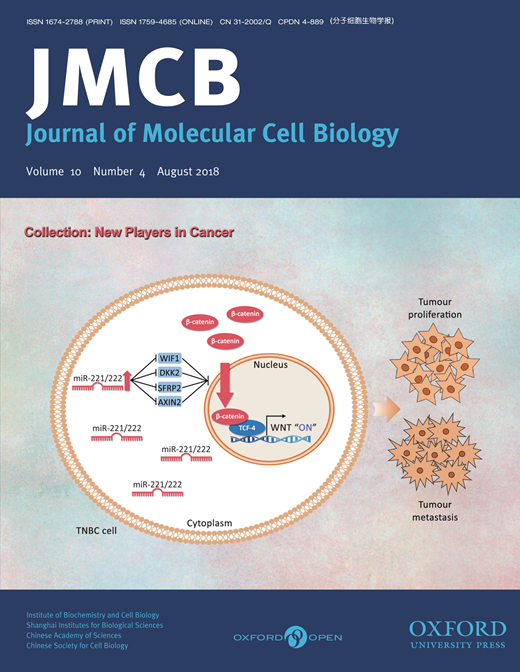Recently, stem cellbiology group has revealed a new mechanism of Wnt/β-catenin signaling pathwayactivation in triple-negative breast cancer. The research was published inJournal of Molecular Cell Biology as “Cover story” with the title ofMiR-221/222 activate the Wnt/beta-catenin signaling to promote triplenegative breast cancer.
Breast cancer is the mostinvasive cancer in women. Triple negative breast cancer (TNBC), characterizedby the lack of expression of the estrogen receptor (ER), the progesteronereceptor (PR), and the human epidermal growth factor receptor 2 (HER-2), is anaggressive form of cancer that conveys unpredictable and poorprognosis due to limited treatment options and lack of effectively targetedtherapies. It accounts for approximately 15�20% of breast cancer patients.Although considerable progress has been made in breast cancer research, themortality rate of TNBC has remained unchanged in the last decade primarily dueto the lack of specific target.
Wnt/β-catenin signalingis hyperactivated in TNBC, which promotes the progression of TNBC. However, themolecular mechanism of Wnt/β-catenin activation in TNBC remains unknown. Inthis study, we report that TNBC cells over-express miR-221/222. Moreover, wedemonstrate by both ex vivo and xenograft experiments that miR-221/222overexpression promotes the proliferation, viability, epithelial-to-mesenchymaltransition, and migration of breast cancer cells. MiR-221/222 achieved so bydirectly repressing multiple negative regulators of the Wnt/β-catenin signalingpathway, including WIF1, SFRP2, DKK2, and AXIN2, to activate the pathway. Furthermore,we show that the level of miR-221/222 expression is inversely correlated withpatients’ survival; whereas that of their target genes in the Wnt/β-cateninpathway is positively correlated to the patients’ survival. Remarkably,anti-miR-221/222 significantly increase apoptosis with tamoxifen/Wnt3atreatment but not with cyclophosphamide/Wnt3a treatment. These results revealthe causal regulatory relationship between miR-221/222 and the Wnt signalingpathway as well as their critical roles in TNBC. In addition, our study offersa new entry point for TNBC treatment.
The main authors are Sanhong Liu ResearchAssociate Professor, Zifeng Wang and Zukai Liu SIAIS graduate student. Thecorresponding author are Sanhong Liu and Haifan Lin. The work has been financedby NSFC.
Link to full paper: https://academic.oup.com/jmcb/article/10/4/302/5059631

Fig1. The cover of JMCB



